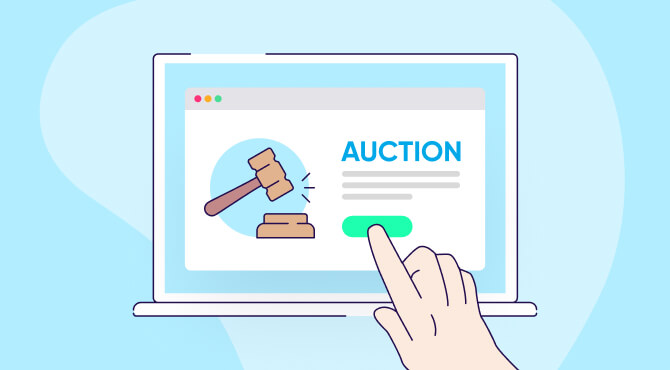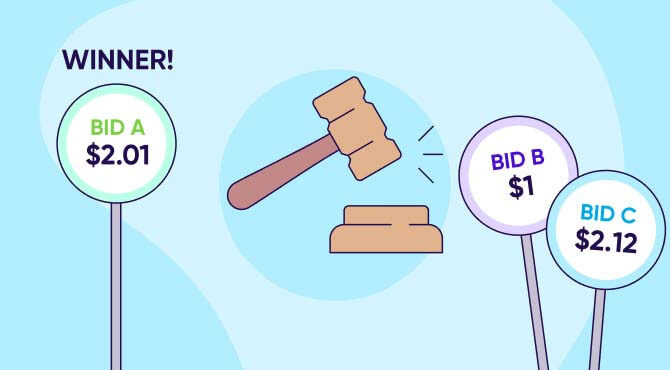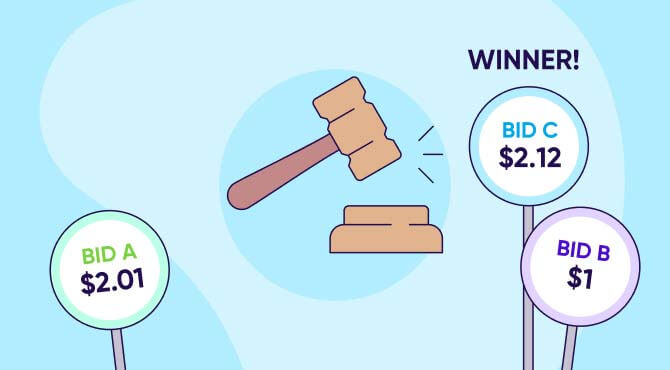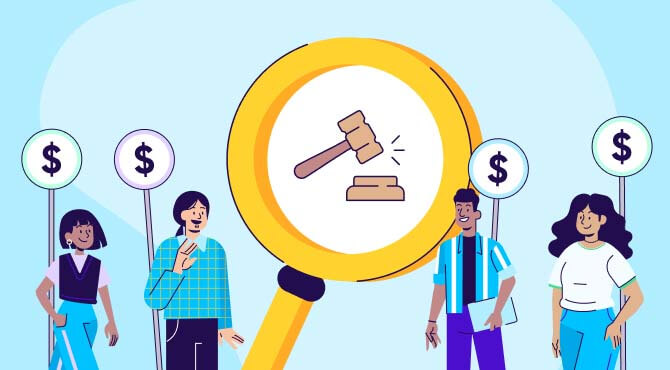
Second price auction
Second price auction is a bidding model in programmatic advertising, where the winner pays $0.01 more than the second-highest bidder to display an impression of their ad.
What is a second price auction?

Second price auction is a type of auction model used in programmatic advertising. As advertisers bid for ad impressions, the highest bidder wins — but there’s a catch: instead of paying their own bid amount, the winner pays the second-highest bid amount plus one US cent.
Consider this example involving three different advertisers:
- Advertiser A bids $2
- Advertiser B bids $1
- Advertiser C bids $2.12

Though Advertiser C is the highest bidder and wins the auction, they don’t pay their initial bid of $2.12. Instead, they pay $2.01 for the ad impression — the second-highest bid ($2 from Advertiser A) + $0.01.
When talking about second price options, it’s important to mention the bid floor.
While not mandatory, a bid floor sets a minimum amount that auction participants must meet or exceed when placing their bids. As well as ensuring better deals for publishers, this ensures transparency and integrity in the auction process, creating an environment where participants are motivated to submit bids that genuinely reflect the value they place on advertising.
How is it different from first price auction?
In a first price auction, the highest bidder wins, and they pay the exact amount they bid for the item or service. It’s a straightforward model where the winning bidder’s proposed price determines the transaction cost.
Here’s a brief breakdown:
- Bid winner: The participant with the highest bid is declared the winner.
- Payment: The winner pays the amount they bid, so there’s a direct correlation between the bid amount and the final price.
So, in our previous example, Advertiser C will win the auction again, but this time, they’ll be paying $2.12.

In contrast, a second price auction introduces a unique pricing mechanism. The highest bidder still wins, but they don’t pay their proposed amount. The specifics look something like this:
- Bid winner: The participant with the highest bid is still the winner.
- Payment: Instead of paying their bid amount, the winner pays the amount of the second-highest bid, plus $0.01.
Which is better: First price or second price?
Each auction model has its pros and cons — let’s compare them.
First price auction:
- Advantages: Simple and intuitive; participants pay what they’re willing to bid.
- Disadvantages: Bidders might strategically submit lower bids than their true valuation, leading to inefficient pricing; the winner might pay more than the actual value they placed on the item.
Second price auction:
- Advantages: Encourages fair bidding; participants have less incentive to manipulate their bid. Efficient pricing.
- Disadvantages: Bidders may find it difficult to strategize due to the indirect relationship between their bid and payment.
Deciding between first price and second price auctions depends on a few things like
transparency, bidder behavior, and how much complexity you’re willing to deal with. If you prefer to keep things simple, go for the first price auction. But if you want a fair and honest bidding process, then the second price auction is the way to go.
In both cases, setting a bid floor is optional but helpful for preventing unrealistically low (or high) bids.
What are the benefits of using second price auction over first price?
Choosing a second price auction over a first price auction yields multiple advantages, such as:
Fair, truthful bidding
The emphasis on truthful bidding in a second price auction encourages participants to bid their actual value, fostering honesty in the auction process. This contrasts with first price auctions, where bidders might strategically undervalue themselves.
Reduces overvaluation risks
Ever heard about the winner’s curse? It refers to a situation where the winning bidder in a first price auction might end up overpaying if their bid significantly exceeds the actual value of the item. In a second price auction, the winner avoids this issue by paying the lower, second-highest bid.
Simplicity in valuation
Bidders in second price auctions don’t need to precisely estimate an item’s value to avoid overpaying; they simply bid their true value, streamlining the bidding process.
Transparency in the market
The predictability of the second price auction allows advertisers to better understand market dynamics. This insight helps them make informed decisions, avoiding inflated perspectives and enabling more competitive, data-driven practices.

Predictable costs
Predictable costs in a second price auction help bidders with budget planning. Knowing they’ll pay the second-highest bid plus a small increment provides a clear and predictable cost structure, enhancing financial planning and management.
Encourages participation
In a second price auction, participants feel more at ease and motivated to engage, knowing the outcome is determined by the second-highest bid rather than their own bid. This fosters a more dynamic and inclusive auction environment.
Bid strategies for second price auctions
Now to the fun bit!
Let’s delve into key bid strategies you can apply for second price auctions:
1 — True value bidding
Strategy: Participants in a second price auction are encouraged to bid their true value for an item or impression. This means placing a bid that accurately reflects the maximum amount they’re willing to pay. For instance, if you believe an impression is worth $2 to you, bid exactly $2 for an honest reflection of the impression’s value.
Why it works: Bidders can be confident they’ll pay only the second-highest bid amount, promoting honesty and transparency. This approach helps you avoid overpaying while remaining competitive.
2 — Bid shading
Strategy: Bid shading involves adjusting bids to a level just above the expected second-highest bid. Here’s how it works: Suppose the estimated second-highest bid is $1.50. Following the bid shading approach, consider placing a bid at $1.51 to secure the auction while paying a price just above the second-highest bid (hence winning the auction).
Why it works: By shading the bid slightly below the bidder’s true value, you can balance competitiveness and cost-effectiveness. This tactic helps secure the win while paying a lower price.
3 — Dynamic bidding
Strategy: Adapt your bids dynamically based on real-time auction conditions, competitor behavior, and performance data. For example, if a sudden influx of competing bids occurs, adjust your bid upward to stay competitive and increase your chances of winning.

Why it works: Bidders continually analyze the auction landscape, adjusting bids based on factors like the number of competing bidders, historical bid patterns, and the value of the impression. This approach ensures your bids remain relevant and competitive.
4 — Bid experimentation
Strategy: Conduct bid experiments by testing different bid amounts to assess their impact on winning auctions and achieving campaign objectives. For example, make bids of $1.50, $2.00, and $2.50 to analyze which bid level consistently results in winning auctions while achieving campaign objectives.
Why it works: Bid experiments are great for understanding the optimal bid level for your goals. This data-driven approach helps you refine bidding strategies over time.
5 — Budget allocation
Strategy: Allocate your budget strategically across multiple auctions to maximize overall campaign performance. If certain auctions consistently yield better results, allocate more of your budget to those auctions to maximize returns.
Why it works: Instead of focusing solely on individual bids, consider your broader campaign budget. This involves allocating funds to auctions with higher potential returns while staying within your overall budget constraints.
6 — Competitor analysis
Strategy: Monitor and analyze competitors’ bidding behavior to gain insights into their strategies. For example, if a competitor consistently wins auctions with higher bids during peak hours, adjust your bidding strategy to remain competitive.
Why it works: Observing and understanding how competitors bid in the auction enables you to adjust your bidding strategies accordingly, ensuring a more informed and competitive approach.
7 — Auction segmentation
Strategy: Segment your bids based on different factors such as audience segments, time of day, or device types. For instance, bid higher for impressions targeted at a premium audience segment. Similarly, adjust bids based on the historical performance of certain devices.
Why it works: By tailoring bids to specific segments, you can optimize your bidding strategy for different audience behaviors and preferences, improving the efficiency of bid allocation.
8 — Bid floor optimization
Strategy: Experiment with bid floors to find the optimal minimum bid that balances competitiveness and efficiency. For example, test bid floors at $1.00, $1.25, and $1.50 to identify the minimum bid that ensures competitiveness without overpaying for impressions.

Why it works: Bid floors set the minimum acceptable bid, and optimizing this value helps strike a balance between winning auctions and controlling costs.
9 — Bid adjustments
Strategy: In your bid strategy, you make bid adjustments based on factors like audience targeting, device types, or geographic locations. Consider increasing bids for impressions from a high-value audience segment, or adjusting bids higher during peak hours to enhance visibility and competitiveness.
Why it works: By adjusting bids for specific conditions or segments, you can optimize your strategy to maximize the chances of winning auctions in scenarios where certain factors influence the value of impressions differently.
Key takeaways
- In a second price auction, the winning bidder pays a price just above the second-highest bid, creating a distinctive pricing mechanism where the highest bid doesn’t determine the final cost.
- While not obligatory, a bid floor, setting a minimum amount participants must meet, ensures transparency and integrity in the auction. This approach encourages participants to submit truthful bids.
- The main difference between first price auction and second price auction lies in how winners determine their payment. In a first price auction, the highest bidder pays exactly their proposed amount.
- The first price auction is straightforward but can result in inefficient pricing due to strategic bidding. In contrast, the second price auction promotes fair and honest bidding, lowering the risk of overvaluation. However, it can be challenging to strategize due to the indirect link between bid and payment.
- Second price auction offers several advantages, including promoting fair and truthful bidding. It mitigates the risk of overvaluation, simplifies the valuation process, provides predictable costs for budget planning, and encourages broad participation in the auctions.
- As a bidder, you can deploy various bid strategies to navigate second price auctions effectively. These strategies include bid shading, bid adjustments, dynamic bidding, and competitor analysis.



